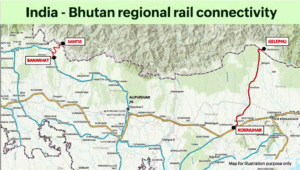
Why in News:
The rise of quick commerce in India has become a transformative trend, reshaping the e-commerce landscape. Ventures like Zepto, Blinkit, and Dunzo have gained prominence by offering instant delivery services for essentials, catering to consumer demand for speed and convenience.
Introduction:
- Quick commerce (q-commerce) is a disruptive model in the e-commerce sector, focusing on ultra-fast delivery of goods, typically within 10-30 minutes. It caters to modern consumer preferences for instant gratification in urban areas.
- With India’s e-commerce market projected to reach $200 billion by 2026, quick commerce’s current $5.5 billion market share represents significant growth and potential for transformation in retail services.
Key Features of Quick Commerce:
- Delivery Speed:
- Ultra-fast delivery within 10-30 minutes.
- Ensures immediate access to essentials like groceries and medicines.
- Product Range:
- Primarily limited to Fast-Moving Consumer Goods (FMCGs), groceries, medicines, and personal care products.
- Gradually expanding product categories.
- Inventory Model:
- Operates via micro-warehouses or dark stores located near customers.
- Facilitates hyper-local inventory management.
- Target Audience:
- Appeals to impulse buyers and consumers with urgent needs.
- Technology Use:
- Leverages AI for demand forecasting, inventory optimization, and route planning.
- Environmental Impact:
- Challenges include higher emissions from frequent small deliveries and increased packaging waste.
Key Opportunities Associated with Quick Commerce:
- Enhanced Urban Convenience:
- Addresses growing urban demand for instant delivery.
- Post-COVID-19, urban consumers increasingly rely on platforms like Blinkit and Swiggy Instamart.
- Fact: India’s internet user base is expected to surpass 900 million by 2025.
- Boost to Employment and Gig Economy:
- Creates jobs for delivery personnel and micro-warehouse staff.
- Strengthens the gig economy by offering flexible earning opportunities.
- Fact: According to NITI Aayog, India’s gig workforce will reach 23.5 million by 2029-30.
- Technology Innovation:
- Encourages adoption of AI, machine learning, and predictive algorithms.
- Enables experiments like drone-based deliveries and dark store models.
- Tier-2 and Tier-3 Expansion:
- Growing potential for penetration into smaller cities.
- Fact: 60% of India’s e-commerce demand in 2023 came from Tier-2 and Tier-3 cities.
- Emergency Deliveries:
- Crucial for delivering medicines, baby products, and essentials during emergencies.
- Startup Ecosystem Growth:
- Attracts venture capital and boosts India’s startup ecosystem.
- Fact: Zepto became India’s 84th unicorn in 2023.
Challenges in the Quick Commerce Landscape:
- Worker Exploitation:
- Delivery personnel face pressure to meet fast timelines, leading to unsafe working conditions.
- Lack of social security and fair wages.
- Business Model Sustainability:
- Heavy reliance on discounts and investor funding.
- Operational costs often outweigh profits, raising concerns about long-term viability.
- Impact on Local Stores:
- Quick commerce disrupts kirana stores, reducing their footfall and sales.
- Urban Infrastructure Strain:
- Adds to traffic congestion and pollution in cities.
- Fact: Mumbai and Bengaluru rank among the most congested cities globally.
- Environmental Concerns:
- Increases carbon emissions and packaging waste.
- Lack of sustainable logistics practices.
- Limited Rural Reach:
- Growth restricted to urban hubs due to logistical challenges and lower demand in rural areas.
- Consumer Protection Issues:
- Quality compromises and inconsistent refund policies.
- Lack of transparency in pricing and delivery charges.
Government’s Role in Regulating Quick Commerce:
- Labor Protections:
- Enforce fair wages, insurance, and safety measures under the Code on Social Security, 2020.
- Delivery Standards:
- Introduce minimum delivery time mandates to prevent unsafe practices.
- Sustainability:
- Promote eco-friendly practices, such as adopting electric vehicles (EVs) under the FAME scheme.
- Centralized Regulation:
- Establish a National E-Commerce Regulatory Authority to monitor fair practices and ensure compliance.
- Consumer Protection:
- Strengthen laws under the Digital Personal Data Protection Act, 2023.
- Mandate transparent refund and grievance redressal policies.
- MSME Integration:
- Mandate platforms to source inventory from MSMEs and local businesses.
- Tier-2 and Tier-3 Expansion:
- Link expansion incentives with government schemes like PM Gati Shakti to improve rural infrastructure.
Conclusion:
Quick commerce is revolutionizing retail in India by offering unparalleled speed and convenience. While it drives innovation, employment, and market expansion, challenges like worker exploitation, environmental impact, and competition with kirana stores necessitate balanced regulation. A centralized authority, strong labor protections, and sustainable practices are vital for long-term growth. For aspirants, understanding this evolving sector’s dynamics offers insights into the intersection of technology, economics, and policy-making.
Glossary of Key Terms:
- Quick Commerce (Q-Commerce): Ultra-fast delivery model focusing on essentials.
- Dark Stores: Localized warehouses that facilitate faster deliveries.
- Gig Economy: Labor market characterized by short-term, flexible jobs.
- Code on Social Security, 2020: Aims to extend social security benefits to gig and platform workers.
- FAME Scheme: Promotes faster adoption of electric vehicles in India.
MCQ
- What is the projected value of India’s e-commerce market by 2026?
- $150 billion
B. $200 billion
C. $250 billion
D. $300 billion
Correct Answer: B. $200 billion
Explanation:
India’s e-commerce market is projected to reach $200 billion by 2026, reflecting significant growth driven by increasing internet penetration, urbanization, and evolving consumer behavior.
Why Other Options are Incorrect:
- $150 billion: Underestimates the projected market value.
- $250 billion: Overstates the projection.
- $300 billion: Misrepresents data and exceeds expected growth estimates.
- Which company became India’s 84th unicorn in 2023?
- Blinkit
B. Zepto
C. Swiggy Instamart
D. Dunzo
Correct Answer: B. Zepto
Explanation:
Zepto achieved unicorn status in 2023, emphasizing the rapid rise of quick commerce startups in India.
Why Other Options are Incorrect:
- Blinkit: Prominent in quick commerce but not the 84th unicorn.
- Swiggy Instamart: Not a separate entity achieving unicorn status.
- Dunzo: Established but not a unicorn in 2023.
- What percentage of India’s e-commerce demand in 2023 came from Tier-2 and Tier-3 cities?
- 40%
B. 50%
C. 60%
D. 70%
Correct Answer: C. 60%
Explanation:
In 2023, Tier-2 and Tier-3 cities contributed 60% of the e-commerce demand, indicating growing penetration beyond metros.
Why Other Options are Incorrect:
- 40%: Underestimates the contribution.
- 50%: Does not reflect actual data.
- 70%: Overstates the growth in smaller cities.
- What does the FAME scheme in India primarily promote?
- AI innovation in logistics
B. Faster adoption of electric vehicles
C. Rural e-commerce infrastructure
D. Social security for gig workers
Correct Answer: B. Faster adoption of electric vehicles
Explanation:
The FAME (Faster Adoption and Manufacturing of Hybrid and Electric Vehicles) scheme aims to incentivize the use of eco-friendly vehicles in India.
Why Other Options are Incorrect:
- AI innovation in logistics: Unrelated to the FAME scheme.
- Rural e-commerce infrastructure: Not the scheme’s focus.
- Social security for gig workers: Falls under the Code on Social Security, 2020.
- What is a dark store in the context of quick commerce?
- A warehouse operating at night
B. A hyper-localized warehouse for fast deliveries
C. A physical retail store with no online presence
D. A store selling discontinued products
Correct Answer: B. A hyper-localized warehouse for fast deliveries
Explanation:
Dark stores are small, strategically located warehouses designed to fulfill online orders quickly.
Why Other Options are Incorrect:
- A warehouse operating at night: Misinterpretation of “dark.”
- A physical retail store with no online presence: Does not align with the concept.
- A store selling discontinued products: Incorrect definition.
- By which year is India’s gig workforce expected to reach 23.5 million?
- 2025
B. 2027
C. 2029-30
D. 2035
Correct Answer: C. 2029-30
Explanation:
According to NITI Aayog, India’s gig workforce is projected to grow to 23.5 million by 2029-30, reflecting the expanding gig economy.
Why Other Options are Incorrect:
- 2025: Too early for this estimate.
- 2027: Not the projected year.
- 2035: Exceeds the specified timeline.
- What challenge does quick commerce pose to kirana stores?
- Lack of inventory tracking
B. Reduced footfall and sales
C. Increased labor costs
D. Limited product range
Correct Answer: B. Reduced footfall and sales
Explanation:
Quick commerce attracts consumers who might otherwise shop at local kirana stores, leading to reduced foot traffic and sales for these traditional outlets.
Why Other Options are Incorrect:
- Lack of inventory tracking: Not directly affected by quick commerce.
- Increased labor costs: Not a challenge for kirana stores.
- Limited product range: Does not relate to kirana stores.
- Which technology is essential for route optimization in quick commerce?
- Blockchain
B. Artificial Intelligence (AI)
C. Quantum Computing
D. Internet of Things (IoT)
Correct Answer: B. Artificial Intelligence (AI)
Explanation:
AI is widely used in quick commerce for demand forecasting, inventory optimization, and route planning.
Why Other Options are Incorrect:
- Blockchain: Not directly used for route optimization.
- Quantum Computing: Still in experimental stages for logistics.
- IoT: Supports but does not handle route planning.
- What is the primary environmental challenge associated with quick commerce?
- Landfills from unsold inventory
B. High carbon emissions and packaging waste
C. Overuse of renewable energy
D. Deforestation for dark store construction
Correct Answer: B. High carbon emissions and packaging waste
Explanation:
Frequent small deliveries and excessive packaging contribute significantly to environmental degradation in quick commerce.
Why Other Options are Incorrect:
- Landfills from unsold inventory: Not a primary challenge.
- Overuse of renewable energy: Misleading and incorrect.
- Deforestation for dark store construction: Not relevant.
- Which government initiative links infrastructure development to rural commerce expansion?
- PM Gati Shakti
B. Digital India
C. Startup India
D. Make in India
Correct Answer: A. PM Gati Shakti
Explanation:
PM Gati Shakti focuses on improving infrastructure to facilitate growth, including rural commerce expansion.
Why Other Options are Incorrect:
- Digital India: Focuses on digital infrastructure.
- Startup India: Aims to promote entrepreneurship.
- Make in India: Encourages manufacturing, not infrastructure linkage.
- Which of the following is a major challenge to the sustainability of the quick commerce business model in India?
- High consumer demand in rural areas
- Over-reliance on discounts and investor funding
- Inadequate demand forecasting
- Limited product categories
Correct Answer: B. Over-reliance on discounts and investor funding
Explanation: Quick commerce businesses often rely on discounts and substantial investor funding to maintain low prices, which raises concerns about long-term profitability. This reliance makes the model unsustainable without a shift towards profitability.
Related Fact: Many quick commerce businesses struggle to achieve a balance between attracting customers and covering operational costs, leading to unsustainable business practices.
- Which sector in India is projected to see the highest growth in the gig economy by 2029-30?
- Healthcare
- E-commerce delivery
- IT services
- Education
Correct Answer: B. E-commerce delivery
Explanation: With the rapid expansion of e-commerce and quick commerce, the e-commerce delivery sector is expected to see significant growth, accounting for a large portion of India’s gig workforce by 2029-30.
Related Fact: NITI Aayog estimates India’s gig workforce will reach 23.5 million by 2029-30, with a substantial share in delivery services.
- Which city in India is ranked among the most congested cities globally, impacting the quick commerce delivery ecosystem?
- Chennai
- Mumbai
- Kolkata
- Hyderabad
Correct Answer: B. Mumbai
Explanation: Mumbai is known for its severe traffic congestion, which poses a challenge to quick commerce delivery services, leading to delays and increased operational costs.
Related Fact: Bengaluru also ranks among the most congested cities, impacting delivery timelines for quick commerce.
- What percentage of India’s gig workforce is expected to consist of women by 2029-30?
- 5%
- 10%
- 15%
- 20%
Correct Answer: B. 10%
Explanation: According to various reports, women make up a growing share of the gig economy, though they still represent a smaller portion compared to men. The gig economy presents flexible earning opportunities that are becoming increasingly accessible to women.
Related Fact: The government has also focused on improving social security for gig workers, particularly women, under the Code on Social Security, 2020.
- Which of the following is a significant environmental concern related to quick commerce?
- Overuse of renewable energy
- Air pollution from delivery vehicles
- Reduction in greenhouse gas emissions
- Deforestation for dark store construction
Correct Answer: B. Air pollution from delivery vehicles
Explanation: Quick commerce leads to an increased number of delivery vehicles on the road, contributing to higher emissions, which significantly impact urban air quality.
Related Fact: The adoption of electric vehicles (EVs) under schemes like FAME aims to reduce emissions from quick commerce deliveries.
- Which of the following strategies could help address the environmental impact of quick commerce?
- Using drones for deliveries
- Increasing delivery times
- Reducing the use of dark stores
- Encouraging multi-product deliveries
Correct Answer: A. Using drones for deliveries
Explanation: Drones have the potential to reduce traffic congestion and carbon emissions by bypassing traditional delivery routes. They also hold promise for faster, more efficient deliveries in urban settings.
Related Fact: Quick commerce companies are experimenting with drone deliveries as part of their sustainability initiatives.
- Which of the following is NOT an essential feature of quick commerce in India?
- Delivery within 10-30 minutes
- Operating via micro-warehouses
- Product categories limited to luxury items
- Focus on urban consumer needs
Correct Answer: C. Product categories limited to luxury items
Explanation: Quick commerce focuses primarily on essentials like groceries, FMCGs, and medicines, not luxury items. Luxury products are typically not part of the quick commerce model.
Related Fact: The focus of quick commerce is on providing fast access to everyday essentials for urban consumers.
- What role does AI play in quick commerce operations?
- Product marketing and advertising
- Demand forecasting and route optimization
- Customer engagement through chatbots
- Warehouse construction and maintenance
Correct Answer: B. Demand forecasting and route optimization
Explanation: AI is crucial for predicting demand patterns, optimizing inventory levels, and planning the most efficient delivery routes, all of which enhance the speed and efficiency of quick commerce services.
Related Fact: AI also helps in reducing operational costs by predicting peak demand periods.
- What percentage of India’s e-commerce demand in 2023 came from Tier-2 and Tier-3 cities?
- 40%
- 50%
- 60%
- 70%
Correct Answer: C. 60%
Explanation: Tier-2 and Tier-3 cities accounted for 60% of e-commerce demand in 2023, showcasing the growth potential outside the traditional metropolitan hubs.
Related Fact: The rapid growth in these regions is expected to continue, offering significant opportunities for quick commerce platforms.
- What is the primary function of a dark store in the context of quick commerce?
- A retail store with a physical presence
- A centralized warehouse for bulk product storage
- A micro-warehouse for fulfilling online orders
- A factory producing goods for quick delivery
Correct Answer: C. A micro-warehouse for fulfilling online orders
Explanation: Dark stores are small, localized warehouses that focus on fulfilling online orders quickly, usually for essentials like groceries.
Related Fact: These warehouses help quick commerce companies maintain a competitive edge by ensuring fast delivery.
- Which of the following is a major factor driving the expansion of quick commerce in India?
- Increase in rural internet penetration
- Increased demand for luxury goods
- Urbanization and changing consumer habits
- Decreased competition in the e-commerce sector
Correct Answer: C. Urbanization and changing consumer habits
Explanation: As cities grow and consumer habits shift toward faster, more convenient services, quick commerce meets the demand for speedy delivery in urban areas.
Related Fact: The growing internet user base, expected to surpass 900 million by 2025, is fueling the rise of e-commerce, including quick commerce.
- What is the projected market value of India’s quick commerce sector by 2026?
- $5.5 billion
- $15 billion
- $20 billion
- $25 billion
Correct Answer: B. $15 billion
Explanation: Quick commerce is projected to grow from a $5.5 billion market share to $15 billion by 2026, driven by rapid urbanization and technological advancements.
Related Fact: The overall e-commerce market is expected to reach $200 billion by 2026.
- Which of the following is a key factor contributing to the disruption of traditional kirana stores in India?
- Higher product prices in quick commerce platforms
- Ability to offer larger inventories
- Faster delivery times and convenience
- Increased loyalty programs by quick commerce platforms
Correct Answer: C. Faster delivery times and convenience
Explanation: Quick commerce platforms disrupt kirana stores by offering faster deliveries, often within 10-30 minutes, which appeals to urban consumers.
Related Fact: The rise of convenience and instant delivery options has contributed to declining foot traffic in local stores.
- What does the Code on Social Security, 2020 aim to achieve for gig workers in India?
- Provide subsidized healthcare services
- Extend social security benefits and protection
- Guarantee fixed wages for gig workers
- Regulate pricing in the gig economy
Correct Answer: B. Extend social security benefits and protection
Explanation: The Code on Social Security, 2020 aims to provide social security benefits such as insurance, welfare schemes, and safety measures for gig workers, including those in the quick commerce sector.
Related Fact: The act is a step toward integrating gig workers into the formal workforce and ensuring their welfare.
- Which of the following quick commerce startups became India’s 84th unicorn in 2023?
- Zepto
- Blinkit
- Swiggy Instamart
- Dunzo
Correct Answer: A. Zepto
Explanation: Zepto reached unicorn status in 2023, marking the rise of quick commerce as a major sector in India’s startup ecosystem.
Related Fact: The startup ecosystem in India has attracted significant venture capital, especially in tech-driven sectors like quick commerce.
- Which government initiative aims to improve rural infrastructure and facilitate e-commerce growth?
- PM Gati Shakti
- Digital India
- Skill India
- Atal Mission for Rejuvenation and Urban Transformation
Correct Answer: A. PM Gati Shakti
Explanation: PM Gati Shakti is a government initiative aimed at improving infrastructure to boost logistics and expand rural commerce, helping platforms reach smaller towns.
Related Fact: The initiative focuses on multi-modal connectivity to facilitate faster movement of goods across regions.
- Which of the following is NOT a factor contributing to the rise of quick commerce in India?
- Changing urban consumer behavior
- Limited access to internet and digital infrastructure
- Advances in logistics technology
- Post-COVID-19 demand for faster services
Correct Answer: B. Limited access to internet and digital infrastructure
Explanation: Quick commerce thrives in areas with good internet connectivity and digital infrastructure. Limited access would hinder its growth.
Related Fact: India’s internet user base is rapidly expanding, providing a solid foundation for e-commerce, including quick commerce.
- Which company offers services that are an example of quick commerce in India?
- Amazon
- Flipkart
- Blinkit
- Myntra
Correct Answer: C. Blinkit
Explanation: Blinkit, formerly known as Grofers, is a prominent player in the quick commerce sector, offering rapid delivery of groceries and essentials within minutes.
Related Fact: Other players in the sector include Zepto and Swiggy Instamart.
- Which of the following is a core advantage of using micro-warehouses in quick commerce?
- Lower operational costs
- Faster delivery due to local proximity
- Higher product variety
- Larger storage capacity
Correct Answer: B. Faster delivery due to local proximity
Explanation: Micro-warehouses, or dark stores, are located close to consumer hubs, ensuring faster deliveries, which is essential in quick commerce.
Related Fact: These warehouses minimize delivery time by optimizing local inventories and routing.
- What is a potential risk associated with the growth of the gig economy in quick commerce?
- Over-automation of delivery systems
- Labor exploitation and unsafe working conditions
- Reduced technological innovation
- Increased competition among local stores
Correct Answer: B. Labor exploitation and unsafe working conditions
Explanation: Gig workers in quick commerce often face poor working conditions, long hours, and insufficient social security, leading to labor exploitation concerns.
Related Fact: Ensuring fair wages and protection for gig workers is critical to the sector’s sustainability.




